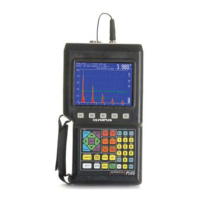Using Software Options
Part # 910-250C
131
9.13 Onboard DGS/AVG
9.13.1 Description
The Onboard DGS/AVG option is a replacement for the old DGS/AVG option that has
been available in the EPOCH 4 and 4PLUS and that required a PC Interface Program for
DGS/AVG setups. This option allows complete DGS/AVG setups to be performed on the
instrument.
The DGS/AVG method allows the operator to size defects based on a calculated DGS/
AVG curve for a given transducer, material, and reflector size. This method requires that
the operator only has one reference reflector in order to create a DGS curve for flaw sizing.
This is much different than the DAC or TVG method, which requires that the operator
have representative defects at various depths within a part in order to create a curve for
flaw sizing.
To allow the operator to setup DGS/AVG curves on the instrument quickly, Olympus
NDT
TM
has developed a transducer library that is stored in the instrument’s memory. This
library contains the entire Atlas Series European specification transducers as well as
several other transducers that are commonly used by inspectors. The library includes four
categories:
1. Contact Transducers (including protected face)
2. Angle Beam Transducers
3. Dual Transducers
4. Custom Transducers
Data needed for building DGS/AVG curves is stored in the instrument’s memory for each
transducer in the library. If an operator would like to use a probe that is not in the default
library, the operator can enter the required transducer characteristics in the GageView Pro
Interface Program and download them to the EPOCH 4PLUS. Probes that are downloaded
to the instrument appear in the Custom Transducers section of the Transducer library.
The Onboard DGS/AVG option provides the operator with rapid setup time and easy flaw
size evaluation. This software option has been designed to meet the requirements of EN
583-2:2001.
Note: It is extremely important that the operator is familiar with the EN 583-2:2001
specification and others, and is qualified according to local standards to
properly use this instrument function. Since the curves used for defect sizing
are calculated based on many variables, a proper instrument setup is required
for accurate results.
9.13.2 Option Activation
Before activating the DGS/AVG option, the operator must properly setup the EPOCH
4PLUS Pulser/Receiver settings for the transducer to be used. The operator should also
perform an instrument calibration.
After the instrument is properly setup and calibrated, the operator should take the
following steps to activate the DGS/AVG option:

